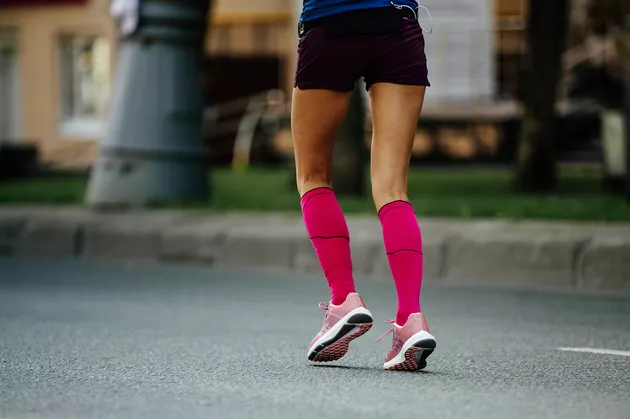
Can I exercise in compression stockings?
Share
For those of us who sit in front of a computer all day, or for those with insufficient blood flow from our legs to our heart—the effects can range from swollen legs and varicose veins, to more serious problems with phlebitis and blood clots— Compression stockings can be a real lifesaver.
Compression socks
This elastic type of socks improves blood circulation by squeezing the leg at the ankle and gradually reducing the tightening of the leg. This progressive squeeze helps circulate blood back to the heart, preventing swelling -- or in more extreme cases -- blood clots, which can form in the legs.
Compression stockings are therapeutic stockings used to support the venous and lymphatic systems of the legs. People who move around often use compression stockings called graded compression stockings.
As the Mayo Clinic explains, these stockings are tighter around the ankle and looser as they rise below or above the knee. Individuals may wear compression stockings on both legs or only one, depending on their purpose.
Compression stockings come in various compressions or pressures. Lighter compressions are available over-the-counter, while larger compressions must be obtained by prescription.
How do compression socks work? What do they do?

Sports elastic socks
Compression stockings treat venous disorders such as chronic venous insufficiency, varicose veins, lymphedema, and postphlebitis syndrome. Compression stockings help circulate blood back to the heart, reduce swelling in the legs and prevent blood clots from forming in the legs.
Postoperative patients often wear compression stockings to prevent blood clots, a common risk after surgery. Because the venous system experiences twice the normal pressure during pregnancy, pregnant women may benefit from wearing compression stockings, which can reduce leg discomfort and prevent varicose veins.
Those who spend most of the day on their feet may benefit from wearing compression stockings, as they are prone to leg swelling and varicose veins. Travelers are advised to wear compression stockings as prolonged sitting can affect blood circulation.
Compression socks and athletes
While compression socks have long been recommended for the modern office worker bees glued to their chairs 24/7, and those on long flights with cramped seats and little legroom in economy class, more recently Athletes started wearing them while running or exercising.
Manufacturers of compression socks and tights claim that these garments aid athletic performance and athletic recovery by increasing oxygen delivery, minimizing muscle fatigue, and preventing cramps and lactic acid.
Whether compression garments actually improve athletic performance and speed recovery is still an unsubstantiated claim. However, one study did find that when 21 male runners performed a one-step test with compression socks and one without compression socks, they were able to run longer before fatigued in the unclothed test. Those who believe that compression stockings enhance physical training attribute to the theory that tights increase muscle efficiency by preventing lateral swaying of the muscles.

Compression stockings and regular exercise
However, for the average fitness enthusiast, wearing compression socks while exercising may have more potentially harmful effects. The general consensus among doctors is that wearing compression garments while exercising won't cause harm, and may actually have some benefits. In addition to potential enhancements to athletic performance and recovery, compression socks have several other benefits. They really keep your legs warm, and if you're out running for a long time, they limit leg swelling.
Still, according to Dr. Umesh Patel, a top cardiologist with 32 years of experience, compression garments are most beneficial when a person is standing and sitting still, and are most detrimental when lying down or exercising because "muscle pumping" Helps with venous return during exercise so less is needed when exercising."
Compression stockings during or after exercise
Recognize the advantage
Some people choose to exercise with compression stockings and report that they improve their performance. According to a March 2015 article in the Journal of Exercise Science and Medicine, researchers have conflicting views on these potential benefits.
The authors also note that although the mechanism remains unclear, wearing compression stockings during exercise appears to reduce tardive muscle soreness and improve exercise recovery.
For people with varicose veins, the Vascular Care Association recommends wearing compression stockings when exercising, as this helps bring the increased blood flow to the legs back to the heart.
Benefits of Compression Socks for Athletes
Be aware of shortcomings
Regardless of their role in exercise, compression stockings take some getting used to. Users find compression stockings difficult to wear, especially if they are older or have obesity or disabilities.
According to an article published in the journal Phlebology in 2018, users also reported adverse side effects, such as sweating and itching, due to the ill-fitting fit, which was detrimental to use.
The study reiterates the importance of proper fit and the need to educate users about the use and proper use of compression stockings. Your compression stockings should be fitted by a qualified nurse or pharmacy or medical supply store specialist.
Another disadvantage of compression stockings is the price. They can be expensive and may or may not be covered by insurance, depending on their purpose.
Get your compression socks
It is recommended that you discuss with your doctor which compression stockings are best for you. Compression stockings come in different pressures and lengths. You can get a prescription from your doctor and go to the medical equipment store, where they will measure your legs to make sure they fit. The most effective compression socks are gradient styles—they feel tight around your legs, with the most pressure around your ankles and less pressure on your legs.










